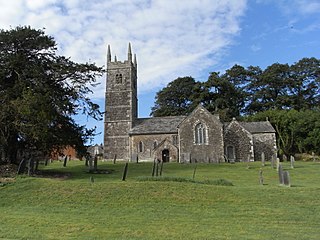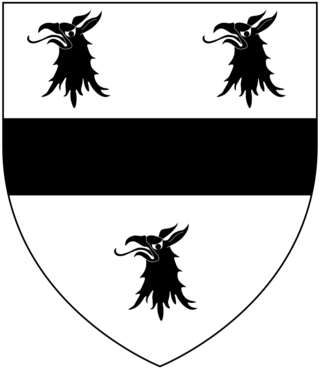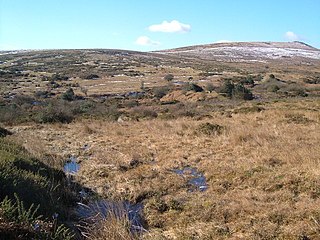
Tamerton Foliot is a village and former civil parish situated in the north of Plymouth, in the Plymouth district, in the ceremonial county of Devon, England. It also lends its name to the ecclesiastical parish of the same name.
Colebrooke is a village and parish in Devon, England about 8 km west of Crediton. The main point of interest is the church and the connection to Henry Kingsley's novel The Recollections of Geoffry Hamlyn. Also Uncle Tom Cobley, of the folk song, signed his will at Pascoe House, but is buried 4 miles west at Spreyton. The champion Devon wrestler, Abraham Cann was born and buried here. He won the all-comers wrestling crown in London.
Bowden is a historic estate in the parish of Yealmpton in Devon, England. From the 15th century until 1748 the manor house was for eight generations the seat of a junior branch of the Copleston family of Copplestone. The manor house was largely rebuilt in the 19th century and, together with some of its outbuildings, now serves as a farmhouse.

Tetcott is a civil parish, small settlement and former manor in Devon, England. The parish lies about five miles south of the town of Holsworthy and is bordered on the north by the parish of Clawton, on the east by a small part of Ashwater, and on the south by Luffincott. It forms part of the local government district of Torridge, and its western boundary is the River Tamar which forms the Cornish border. In 2001 its population was 110, half that of a century earlier.

Colleton is a hamlet and former manor in the civil parish and ecclesiastical parish of Chulmleigh, in the North Devon district of Devon, England. It is situated on the north side of a valley containing the River Taw. Its nearest town is Chulmleigh, which lies approximately 3.6 miles (5.8 km) to the south-west. It consists of the grade I listed Colleton Barton and Colleton Mill, the former manorial mill, with another former industrial building situated at the approach to the bridge over the River Taw.

Huntsham is a small village and civil parish, formerly a manor and ecclesiastical parish, in the Mid Devon district of Devon, England. The nearest town is Tiverton, about 5.8 miles (9.3 km) south-west of the village. The parish is surrounded clockwise from the north by the parishes of Bampton, Hockworthy, Uplowman and Tiverton; it is bounded on the east by the River Lowman and by a minor road on Bampton Down to the north west, where it reaches a maximum height of 914 feet (279 m). In 2001 the population of the parish was 138, down from 222 in 1901.

Fowelscombe is a historic manor in the parish of Ugborough in Devon, England. The large ancient manor house known as Fowelscombe House survives only as an ivy-covered "romantic ruin" overgrown by trees and nettles, situated 1 mile south-east of the village of Ugborough. The ruins are a Grade II listed building.

Sir Thomas Monck of Potheridge in the parish of Merton, Devon, was Member of Parliament for Camelford, Cornwall, in 1626. He was the father of George Monck, 1st Duke of Albemarle (1608–70), KG and of Nicholas Monck, Bishop of Hereford.

Stevenstone is a former manor within the parish of St Giles in the Wood, near Great Torrington, North Devon. It was the chief seat of the Rolle family, one of the most influential and wealthy of Devon families, from c. 1524 until 1907. The Rolle estates as disclosed by the Return of Owners of Land, 1873 comprised 55,592 acres producing an annual gross income of £47,170, and formed the largest estate in Devon, followed by the Duke of Bedford's estate centred on Tavistock comprising 22,607 with an annual gross value of nearly £46,000.

Annery was an historic estate in the parish of Monkleigh, North Devon.

The Manor of Monkleigh was a mediaeval manor centred on the village of Monkleigh in North Devon, England, situated 2 1/2 miles north-west of Great Torrington and 3 1/2 miles south-east of Bideford.

John Arscott (1613-1675), of Tetcott, Devon, was Sheriff of Devon in 1675.

Potheridge is a former Domesday Book estate in the parish of Merton, in the historic hundred of Shebbear, 3 miles south-east of Great Torrington, Devon, England. It is the site of a former grand mansion house re-built by George Monck, 1st Duke of Albemarle (1608–1670) circa 1660 on the site of the former manor house occupied by his family since at the latest 1287. It was mostly demolished in 1734 after the death of the widow of his son Christopher Monck, 2nd Duke of Albemarle.

The estate of Acland in the parish of Landkey, near Barnstaple in North Devon, England, was from 1155 the earliest known seat of the influential and wealthy family of Acland, to which it gave the surname de Acland. It is situated about 3/4 mile north-east of the village of Landkey, from which it is now cut off by the busy A361 North Devon Link Road.

Newnham Park is an historic estate in the civil parish of Sparkwell, Devon, UK. It was known as Loughtor until about 1700 when the ancient Strode family, long seated at Newnham, about 1 mile south-east of the manor house of Loughtor, abandoned Newnham and moved their residence to Loughtor where they built a new mansion house which they renamed "Newnham Park". In 2014 the mansion house with an estate of about 1,550 acres is still owned by a descendant of the Courtenay and Strode families which held the estate from the 15th century, and which were well established in the county of Devon long before that time. In 2014 part of the estate is operated as a commercial clay-pigeon shooting ground.

Kenedon is an historic manor situated in the parish of Sherford in Devon.
Collacombe is an historic manor in the parish of Lamerton, Devon, England. The manor house survives as a grade I listed building, known as Collacombe Barton or Collacombe Manor (House).

Sir Christopher Harris of Radford in the parish of Plymstock in Devon, was a Member of Parliament for Plymouth in Devon in 1584. He was knighted in 1607. He should not be confused with his great-nephew and heir apparent Christopher Harris (d.1623) of Lanrest in the parish of Liskeard in Cornwall, a Member of Parliament for West Looe in Cornwall (1621).

Ernsborough is an historic Saxon estate dating from the 9th or 11th century, situated in the parish of Swimbridge in Devon, England, about 2 miles south-east of the village of Swimbridge. It is best remembered today for having contained during the 14th century a high-status mansion house occupied by the Mules or De Moels family, closely related to Baron Moels of Somerset.

Bagtor is a historic estate in the parish of Ilsington in Devon, England. It was the birthplace of John Ford the playwright and poet. The Elizabethan mansion of the Ford family survives today at Bagtor as the service wing of a later house appended in about 1700.


















